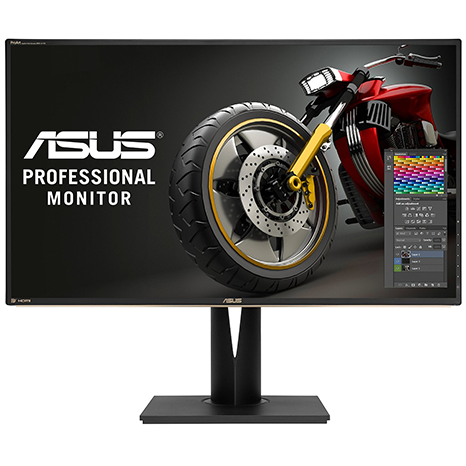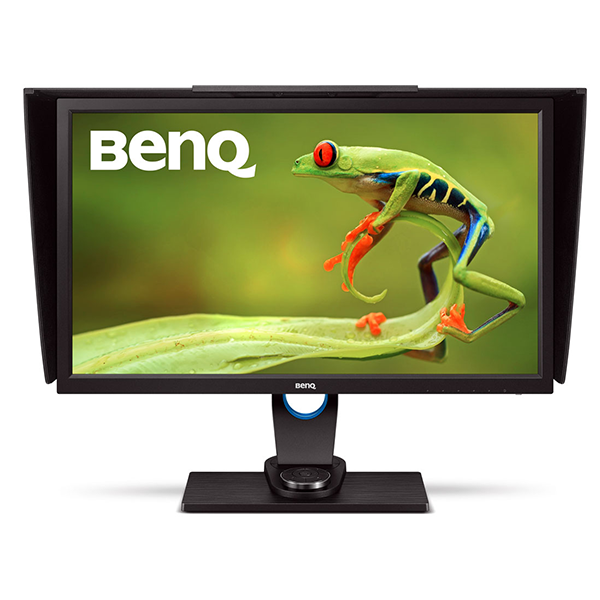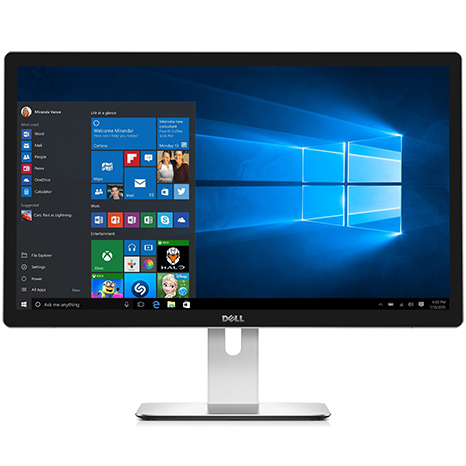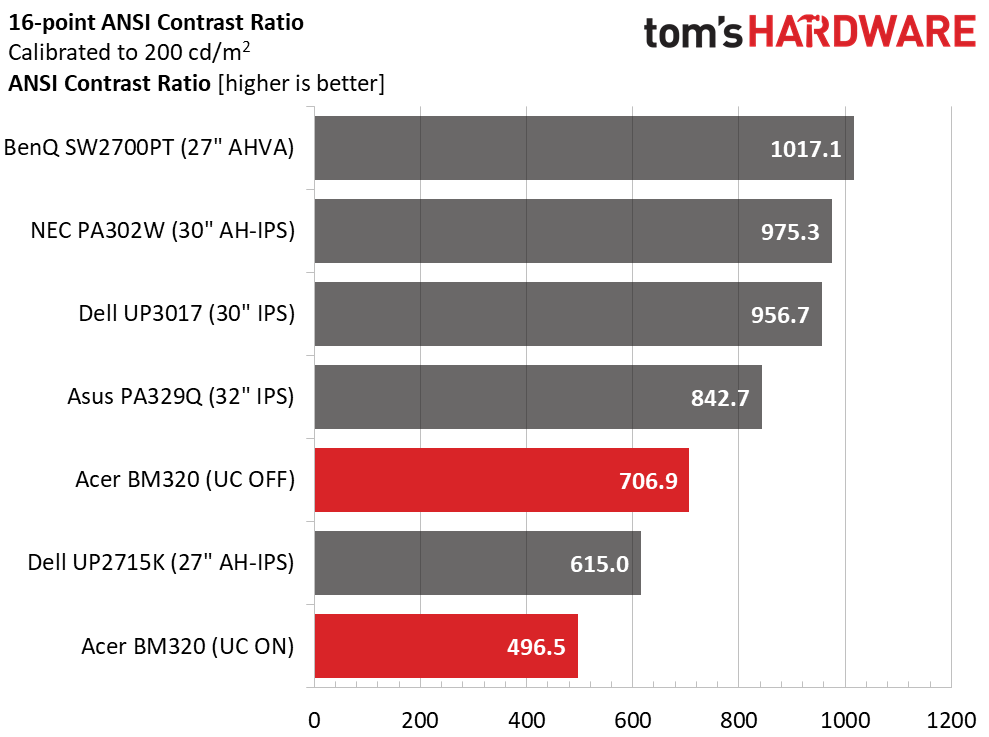Acer ProDesigner BM320 4K Monitor Review
Why you can trust Tom's Hardware
Brightness & Contrast
To read about our monitor tests in depth, please check out Display Testing Explained: How We Test Monitors and TVs. Brightness and Contrast testing is covered on page two.
Uncalibrated – Maximum Backlight Level
We had to reach back in time a bit to come up with five wide-gamut monitors for the comparison group. They are Dell’s UP2715K and UP3017, BenQ’s SW2700PT, Asus’ PA329Q, and NEC’s PA302W. All support Adobe RGB and sRGB color modes and range in resolution from QHD to 5K.
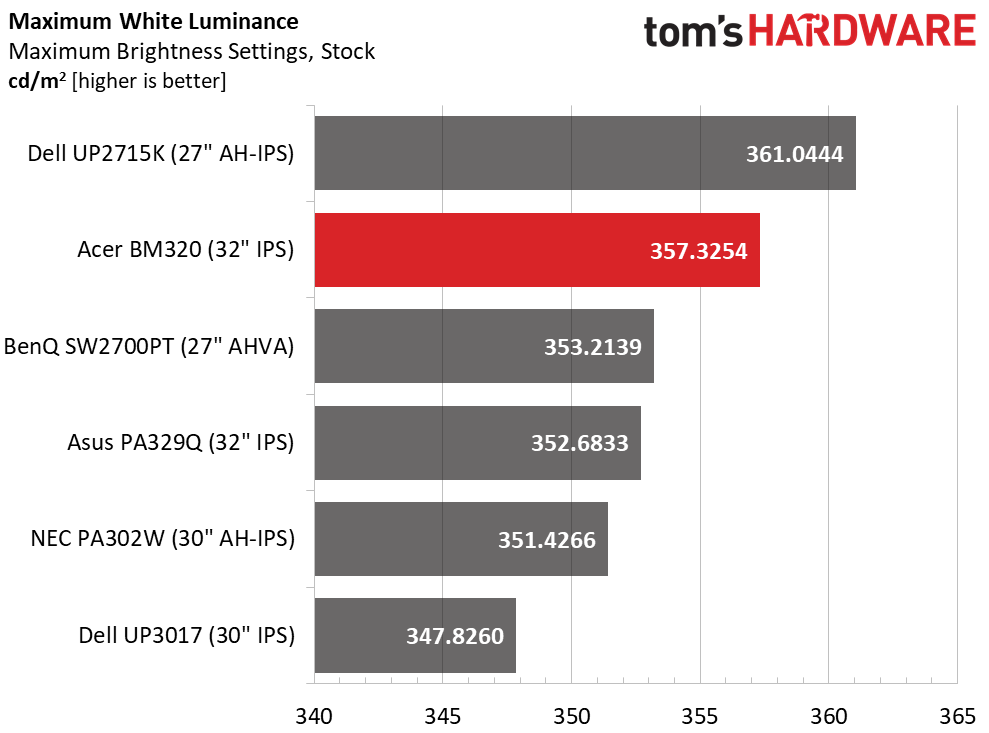
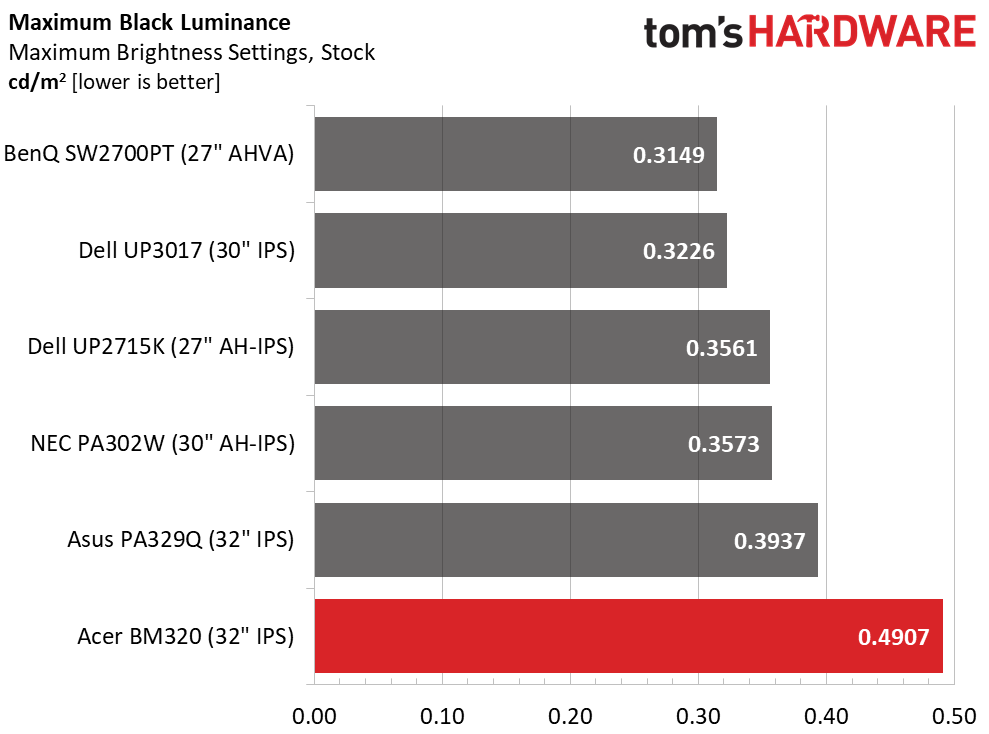
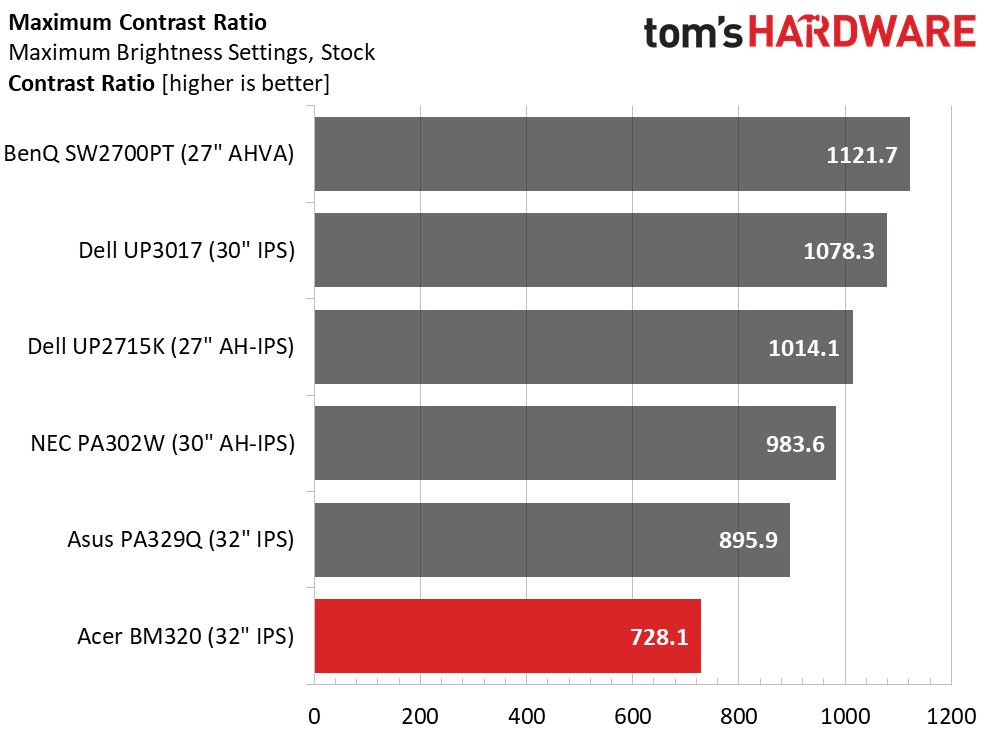
The BM320 beats its 350cd/m2 claim by a few percent, which is more than enough output for any task. The monitor would also work outdoors under cover or with a hood. Thanks to a high black level, contrast is below-average at 728.1:1. You can use the ACM feature to raise this number, but some detail loss will result. All the monitors here use IPS parts, so around 1000:1 is typical, but Acer has missed out on a bit of image depth.
Uncalibrated – Minimum Backlight Level
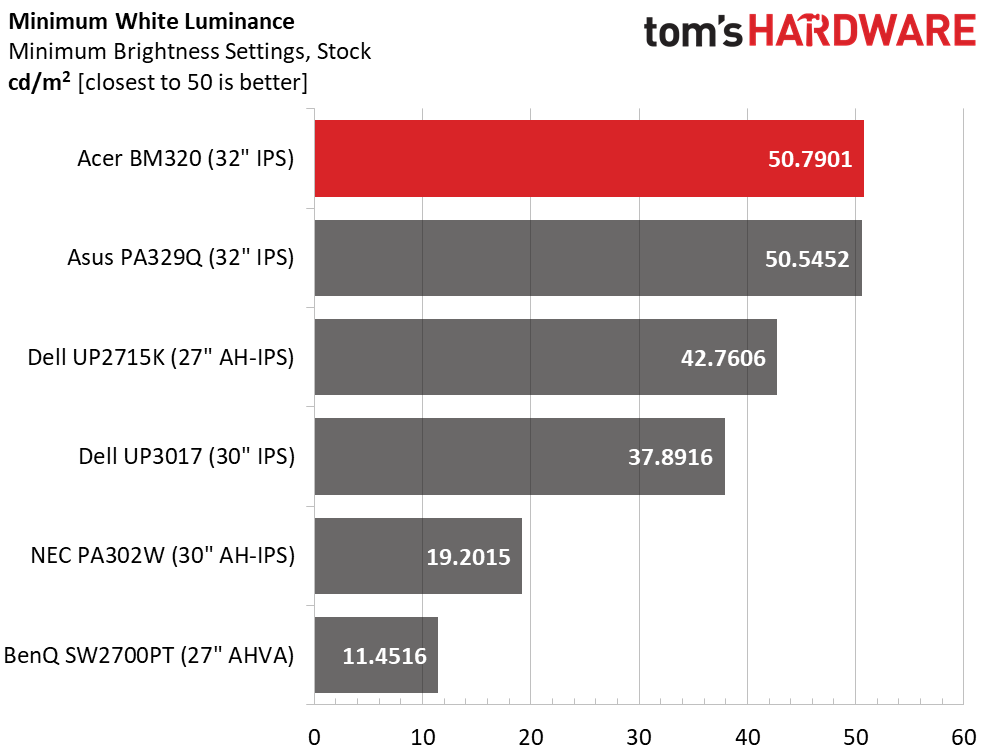
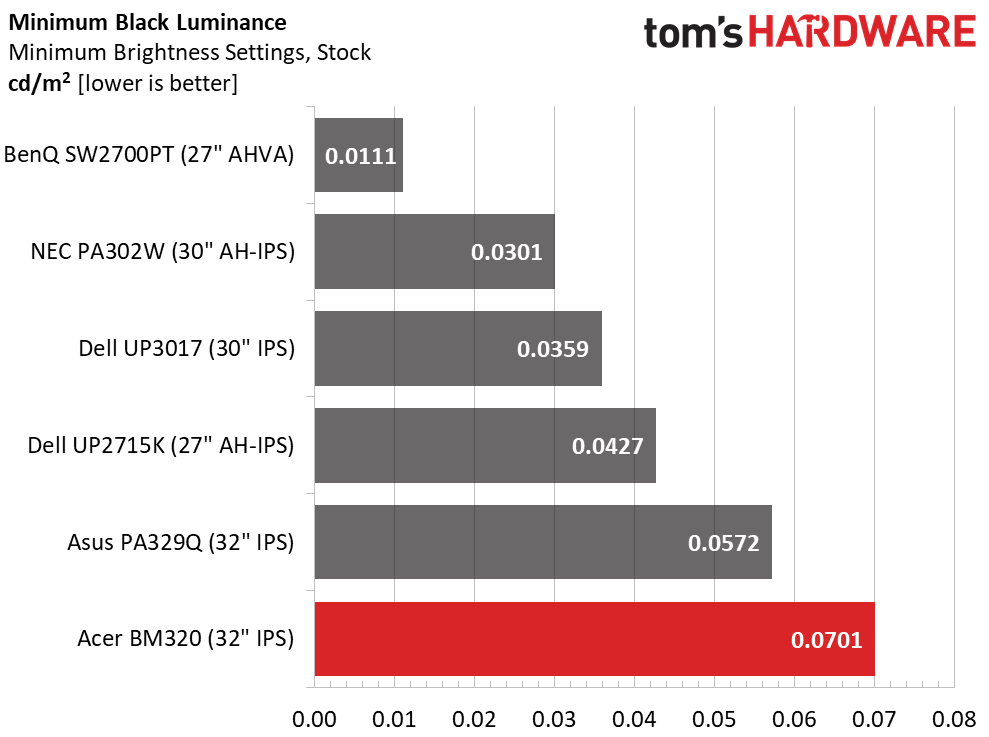
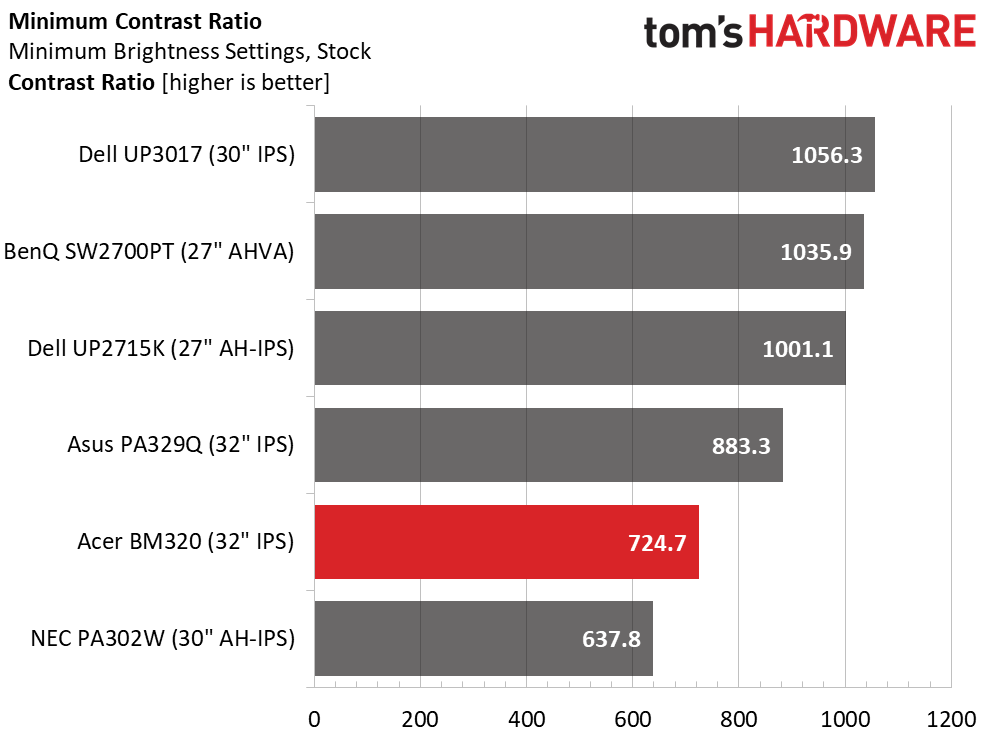
Dropping the brightness slider to zero produces a perfect 50cd/m2 output level. This is ideal for darkened editing suites where there is no light but what’s produced by the other monitors in the room. This is important when matching content to the large wall-mounted screens commonly seen in professional workspaces. You can’t adjust color properly without first equalizing brightness between all displays. The BM320 makes that easy to accomplish. Contrast remains perfectly consistent at 724.7:1.
After Calibration to 200cd/m2
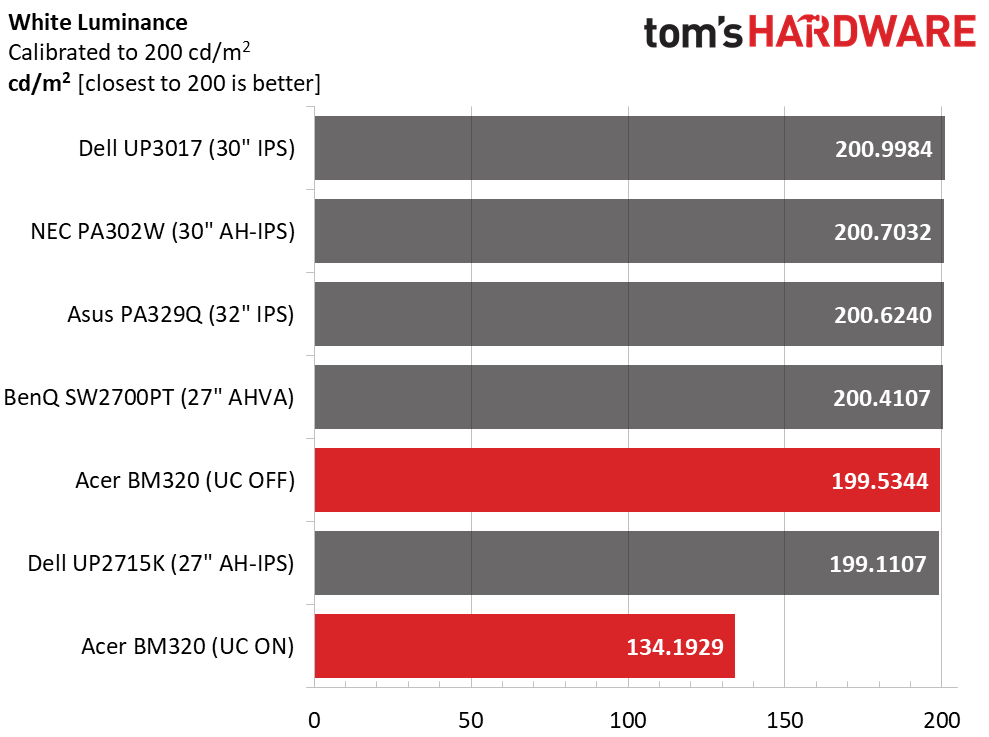
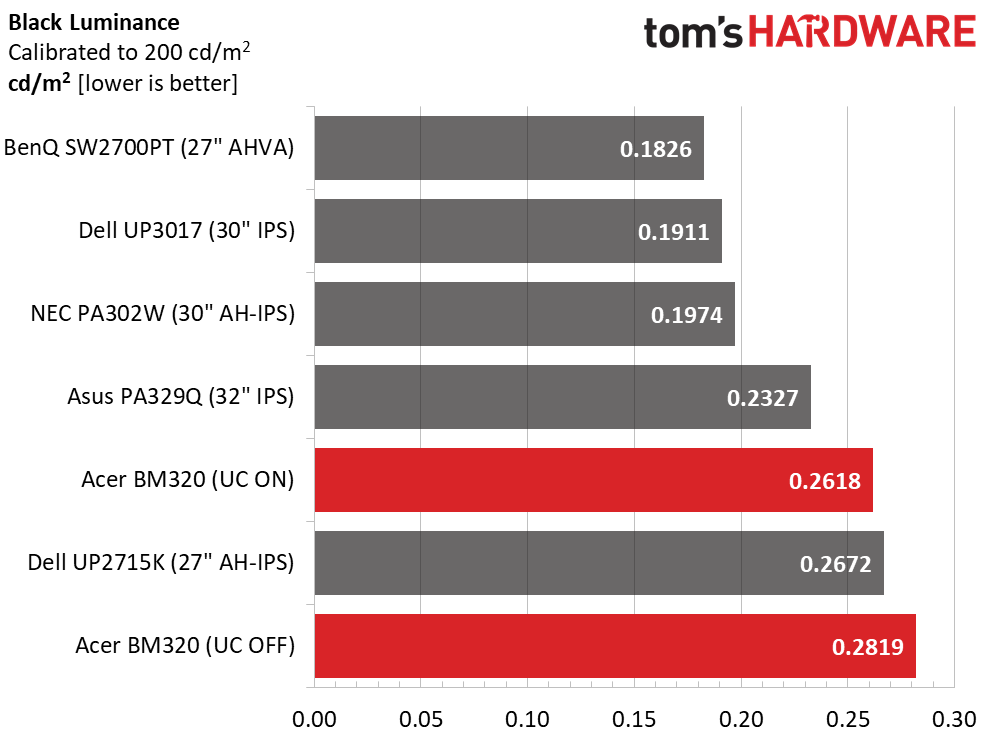
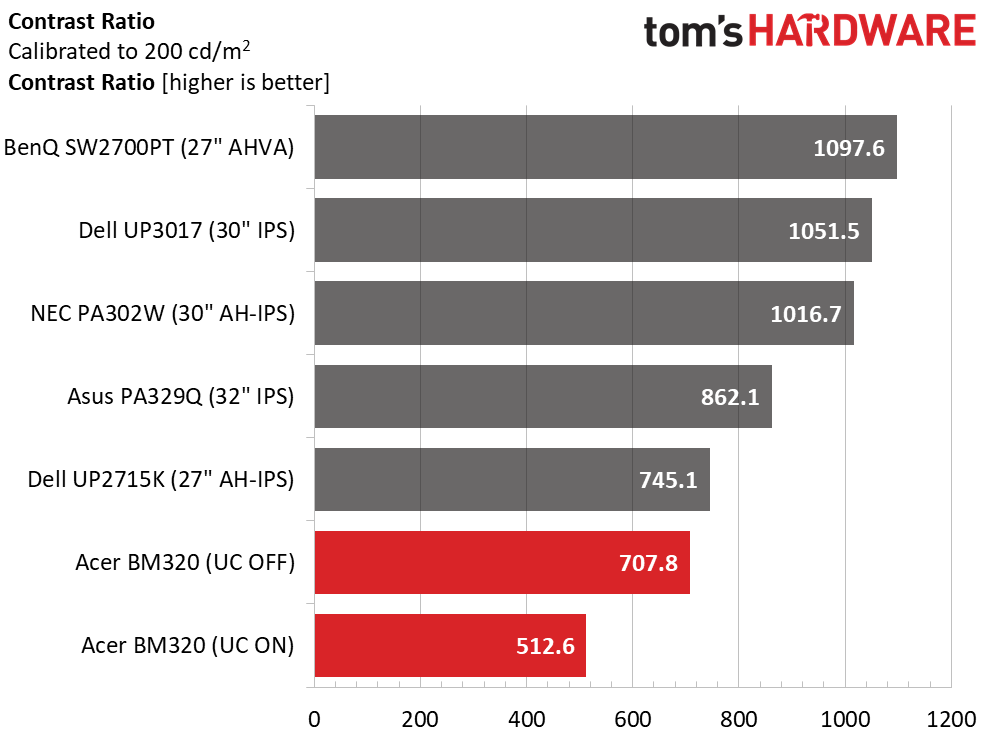
We calibrated the User mode for this test, but we suggest sticking with the factory-calibrated Adobe RGB, sRGB, or Rec.709 presets. Our adjustments lowered contrast a bit to 707.8:1. We’re also showing you the effects of the BM320’s uniformity compensation. Like other monitors with the feature, it reduces contrast. In Acer’s case, black levels aren’t affected much, but peak output drops by 32%. That translates to 27% lower contrast. White field uniformity is improved, but we don’t think it’s worth using when that much dynamic range is lost.
ANSI Contrast Ratio
ANSI contrast is nearly identical to the sequential result, which is a good thing. We just wish there were more dynamic range in general. Uniformity compensation has a similar effect here, reducing the value by 29%. While we are pleased with the BM320’s color accuracy and overall picture quality, greater contrast would be welcome.
MORE: Best Gaming Monitors
Get Tom's Hardware's best news and in-depth reviews, straight to your inbox.
MORE: Best Professional Monitors
MORE: How We Test Monitors
MORE: How To Choose A Monitor
MORE: All Monitor Content
Current page: Brightness & Contrast
Prev Page OSD Setup & Calibration Next Page Grayscale, Gamma & Color
Christian Eberle is a Contributing Editor for Tom's Hardware US. He's a veteran reviewer of A/V equipment, specializing in monitors. Christian began his obsession with tech when he built his first PC in 1991, a 286 running DOS 3.0 at a blazing 12MHz. In 2006, he undertook training from the Imaging Science Foundation in video calibration and testing and thus started a passion for precise imaging that persists to this day. He is also a professional musician with a degree from the New England Conservatory as a classical bassoonist which he used to good effect as a performer with the West Point Army Band from 1987 to 2013. He enjoys watching movies and listening to high-end audio in his custom-built home theater and can be seen riding trails near his home on a race-ready ICE VTX recumbent trike. Christian enjoys the endless summer in Florida where he lives with his wife and Chihuahua and plays with orchestras around the state.
-
kenop Sorry to be an idiot, but I can't figure this out. I use X-Rite's i1 Display Pro, but it requires what I think of as manually calibrating the monitor. So for me, the statements "No gains from manual calibration" and "most users will employ software solutions like CalMAN or X-Rite to get their color spot-on" are contradictory. Can I or can I not use i1 Display Pro to calibrate the BM320? Thank you for another great review!Reply -
kenop And an observation on Acer's warranty: It allows up to THIRTY ONE defective pixels on this monitor (though only one defective pixel is allowed in the central 1/9th portion). Seems like a lot to me, but admittedly I haven't been comparing warranties yet.Reply -
AnimeMania Reply20128953 said:And an observation on Acer's warranty: It allows up to THIRTY ONE defective pixels on this monitor (though only one defective pixel is allowed in the central 1/9th portion). Seems like a lot to me, but admittedly I haven't been comparing warranties yet.
You have to remember there are 8,294,400 pixels on the screen. It is probably hard to produce a 4K monitor with no dead pixels at an affordable price. -
zodiacfml Pretty nice, considering all the specs but could be better with a more sophisticated backlight, thus, improve contrast ratio too.Reply -
ceberle Reply20128914 said:Sorry to be an idiot, but I can't figure this out. I use X-Rite's i1 Display Pro, but it requires what I think of as manually calibrating the monitor. So for me, the statements "No gains from manual calibration" and "most users will employ software solutions like CalMAN or X-Rite to get their color spot-on" are contradictory. Can I or can I not use i1 Display Pro to calibrate the BM320? Thank you for another great review!
You can use an i1 Display Pro to create a lookup table with CalMAN or X-Rite software. Manual calibration refers to adjustments made in the OSD which aren't effective with this monitor.
-Christian- -
kenop Reply
Thank you, Christian, for the clarification. I came to the i1 Display Pro from an earlier model, and I guess I didn't RTFM since I had no idea it could do that. That's exactly what I needed to know. Thanks again!20129650 said:You can use an i1 Display Pro to create a lookup table with CalMAN or X-Rite software. Manual calibration refers to adjustments made in the OSD which aren't effective with this monitor.
-Christian-
-
derekullo Reply20129327 said:OMG i HATE the autoplay video's, why are you wasting bandwidth on this ?
You can use a hosts file from:
http://winhelp2002.mvps.org/hosts.htm
to get rid of ads on most sites.
You can also use a free ad blocking dns, Adguard
https://adguard.com/en/adguard-dns/overview.html
176.103.130.130
176.103.130.131
Personally I use Noscript + AdBlock + Hosts file, which allows me to see 0 ads on Tom's.
No videos, no audio playing, no ads boxing the content with super small X's.
I call this the Destiny 2 approach to ads
https://www.bungie.net/en/Help/Article/46101
I still use google's dns since its faster than all the others.
But for the class I teach on online security the Adguard dns works nearly as well for those unwilling or unable to install a hosts file and or manually configure Noscript.
Does Toms still box you in with ads on all sides?
Is it the same Logitech rgb keyboard video that used to follow you around earlier this year?
-
Novell SysOp fire phasers 5 time Lies. Acer nor Asus have 10-bit panels. All of their monitors are 8+FRC. They are GAME monitor companies, they are not going to give you a pro monitor. Do not trust either company, they are scamming you and you can read it in their forums. False marketing and lying. They can't even be bothered to list the specs on their scam HDR monitors that have been delayed until next year. They refuse to list Adobe, DCI-P3, and rec2020 coverage. And if you cannot get 100% sRGB, you're pathetic.Reply
And the most glaring omission is they fail to tell you you need a Quadro to edit 10-bit. And STFU with contradicting me. I'm in the industry and know more than all of you, and NVIDIA even tell you themselves on their own site. -
slicedtoad Reply20129873 said:Lies. Acer nor Asus have 10-bit panels. All of their monitors are 8+FRC. They are GAME monitor companies, they are not going to give you a pro monitor. Do not trust either company, they are scamming you and you can read it in their forums. False marketing and lying. They can't even be bothered to list the specs on their scam HDR monitors that have been delayed until next year. They refuse to list Adobe, DCI-P3, and rec2020 coverage. And if you cannot get 100% sRGB, you're pathetic.
And the most glaring omission is they fail to tell you you need a Quadro to edit 10-bit. And STFU with contradicting me. I'm in the industry and know more than all of you, and NVIDIA even tell you themselves on their own site.
I'm not an expert by any means when it comes to workstation displays, so these are just questions:
If a 8+FRC panel performs the same as a true 10-bit panel (as in, they achieve the same color accuracy, color depth, etc) is it worse? Or are you listing that as the reason why the color accuracy on this monitor doesn't achieve perfect sRGB?
As for needing Quadro, I thought all 10-bit displays needed workstation GPUs to do 10-bit? And wouldn't that be Nvidia's fault for disabling that on their consumer cards?
